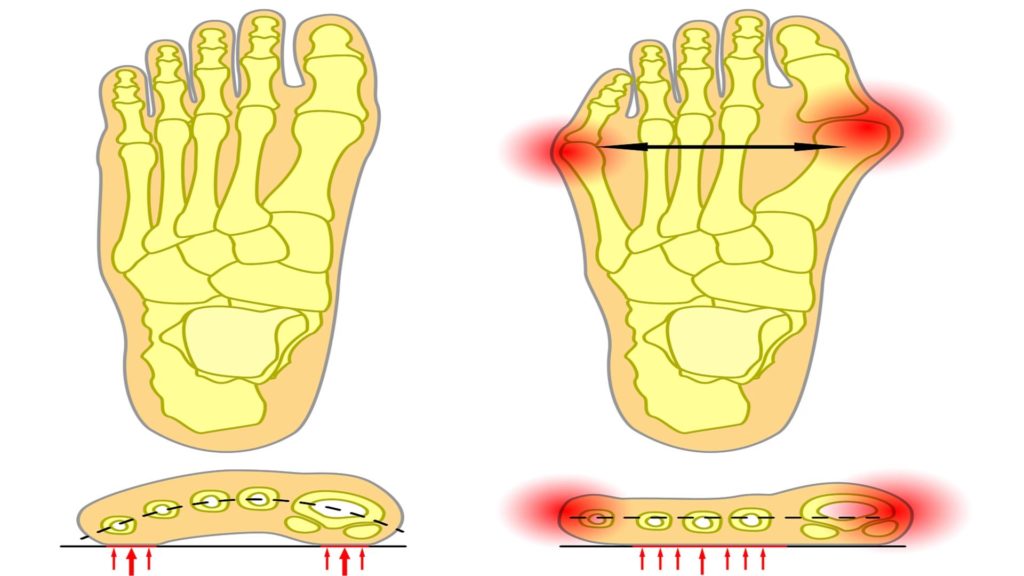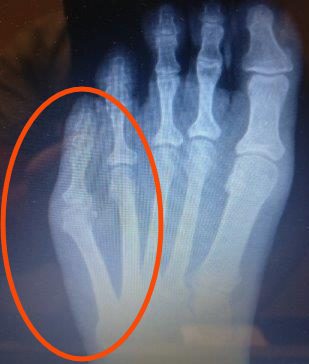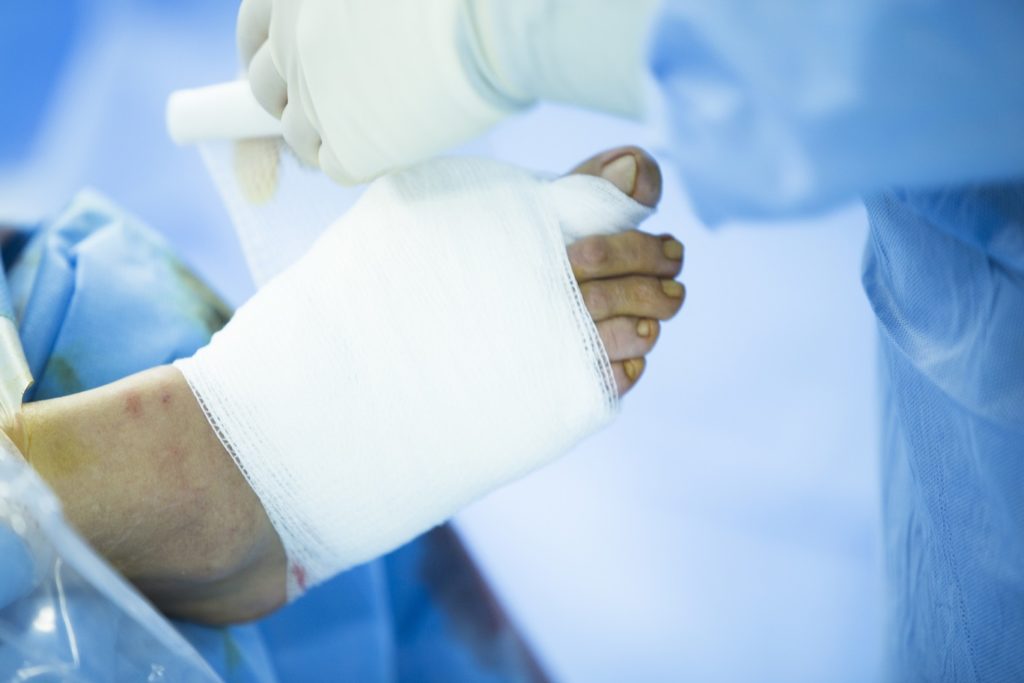Big Toe Joint, Hammer Toe & Bunionette Problems:
How to get rid of bunions on the pinky toe? [Pinky Toe Bunion]
Can you get a bunion on your pinky toe? We review how to get rid of a bunion on the side of the pinky toe or a pinky toe tailor’s bunion!
Table of Contents
Tailor’s Bunionette & Pinky Toe Bunion Corrector Treatment Videos:
Tailor’s bunion & pinky toe bunion video summary:
🦶Do you have a Tailor’s Bunion or bunionette?🦶
- We will show you the absolute best tailor’s bunion treatment & bunionette treatment!
- We go over the best tailor’s bunion surgery and bunionette surgery as a LAST RESORT.
- We review the best bunionette pads, bunionette correctors, and bunionette pads!
- We want to help you get rid of your tailor’s bunion (bunionette) pain!
- This is also known as a bunion on the outside of the foot.
- This is also known as a pinky toe bunion or a fifth toe bunion.

What is a Pinky Toe Bunion?
A bunion is a bony bump that can form on the joint at the base of your pinky toe or little toe.
- Once this bony protrusion sticks out from your toe, the skin over the bunion can become red and sore.
- The inflammation which occurs at the base of your joint may lead to pain or discomfort.
- Pinky toe bunions can develop because of foot deformity.
- If you have arthritis (inflammation of joints) or the shape of your foot is not right, you become more prone to get bunions on your toes.
- A pinky toe bunion is also known as a tailor’s bunion.
Can you get a bunion on your pinky toe?
Yes, a smaller bunion on the outside of the 5th toe is called a bunionette or tailor’s bunion.
- It can develop on the base of the joint of your pinky toe.
It is known as Tailor’s bunion on pinky toe. This bunion is formed on the side of the pinky toe as a bony lump.
- This happens when the 5th metatarsal bone shifts outward or enlarges.
- The very bottom bone on your pinky toe is the 5th metatarsal. Tailor’s bunion grows at the base of your pinky toe, on the outside of the foot.
- They are not as common as regular bunions.
- It can also result from wearing tight-fitting narrow shoes, or this may worsen an already existing bunion on the side of the pinky toe.
- Pinky toe bunion pain can be a common symptom to many of you.
Do you know how Tailor’s bunion got its name?
Here is an interesting fact:
- Tailors sit cross-legged with the edges of their feet pressing against the floor.
- When the pinky toe constantly rubs against the floor, a bump forms at the base of their toes.
- The Tailor’s bunion got its name a long time back due to this reason.

What are the symptoms of bunion of the pinky toe?
You may often experience the following symptoms and signs if you have a bunion near the pinky toe.
- Swelling, soreness, and redness around your pinky toe
- A bulging bump on the outside of the base of your pinky toe
- Continuous pain or pain may come and go – bunion on the pinky toe gives pain, especially when it rubs against your shoe.
- Moving your pinky toe may be difficult or limited
- Corns and calluses can occur in your toes because of the deformed toes rubbing on each other
Tailor’s bunion on the pinky toe can occur on one or both feet.
Pinky toe bunions on one foot may cause more symptoms than the other.
It can start small but may grow larger with time.
It usually starts when you are young and worsens gradually with time.
It can start to become painful, usually after 40 years of age.
What are the causes of developing a bunion on the pinky toe joint?
The exact reason is unknown, although there are many theories on how pinky toe bunions develop. They may include;
- Foot deformities present at birth – Tailor’s bunions are more likely if you have an inherited structural foot deformity.
- Inherited foot types may make you prone to bunions
- Injuries to feet or foot stressors
When the 5th metatarsal bone protrudes outward, the pinky toe moves inward. This shift creates a bump on the outside of your foot that can get irritated whenever your shoe presses against it.
How tight, high heeled or narrow shoes lead to bunions is not proven, and still, experts disagree on this possibility as a cause. However, wearing high heels or ill-fitting shoes may increase your risk of developing pinky toe bunions. As we know, wearing high heels will force our toes into the front of the shoes, leading to crowding of our toes. If your shoes are too tight, too narrow, pointed, or ill-fitting, this can lead to stress on your toes, and you will be more likely to develop not only a bunion on your pinky toe but also your big toe.
Bunions of the pinky toe can be associated with the inflammatory type of arthritis such as rheumatoid arthritis. Heredity may play a role in your tendency to develop bunions because anatomy or the structure of your foot may be an inherited problem.
What are the possible complications of pinky toe bunion?
Bursitis – This is a painful condition where the small fluid-filled pads near your joints become inflamed. These fluid-filled pads are there to cushion your bones and joints and to distribute the pressure well. When they become inflamed, pain is inevitable.
With time your toes can bend abnormally due to continuous pressure. There can be pain and swelling in the area. Although these complications are not life-threatening, they can be quite uncomfortable and may disturb your daily routines.
How to get rid of bunions on the pinky toe?
When should you see a podiatrist or foot doctor??
Usually, bunions do not require any treatment. However, visit your doctor or a podiatrist, or an orthopedic foot specialist (a doctor who specializes in treating foot disorders) if you experience the following symptoms;
- A visible bump or protrusion on your pinky toe which bothers you
- If your pain is ongoing
- If you have decreased movement of your foot
- If you have problems in finding shoes that fit properly because of your pinky toe bunion
How will your podiatrist or foot doctor diagnose pinky toe bunion?
Simply by examining your foot, your doctor can identify a bunion on the pinky toe joint.
- Sometimes an X-Ray of the foot will be taken to determine the treatment options.
- Your podiatrist and foot doctor could also perform a biomechanical exam to help take care of your pinky toe bunion.
How are pinky toe bunions treated?
- The treatment depends on the severity of your bunion and the pain caused by it.
- There are bunion surgery treatment options, but usually, these tailor’s bunions can be corrected without surgery!
What are the home remedies for a bunion on the pinky toe?
These non-surgical treatments can help to relieve the pain and pressure of your bunion.
- Apply ice – if your bunion becomes inflamed or causes pain because you have been on your feet too long, you can apply it to relieve the soreness and swelling. Apply ice packs to the sore area for 5 – 10 minutes 2 -3 times a day. However, if you have any circulation issues or reduced sensation in your feet, especially if you have diabetes, you need to check with your doctor before icing your bunion.
- Change the shoes you wear – Avoid high heels and shoes with pointy toes. Wear comfortable, flexible, and roomy shoes with a wide toe box which provides plenty of space that doesn’t crowd your toes.
- Using a pinky toe bunion pad – there are over-the-counter bunion pads or cushions that can be used between your foot and the shoe. These act as a buffer to ease your pain. There are bunion pads made of silicone which you can apply over the Tailor’s bunion. This will prevent the bunion from rubbing against your shoe.
- Shoe inserts – You can buy over-the-counter supports or prescription orthotic devices like shoe inserts. They will help to distribute the pressure evenly when you move your feet. Custom orthotic devices may be provided by your foot and ankle specialist.
- Using a pinky toe bunion corrector is a splint that helps straighten your pinky toe while separating and protecting your toes.
- You can take acetaminophen (Tylenol) to control the pain from your pinky toe bunion.
- Calf stretches may help as a pinky toe bunion remedy.
Your doctor will prescribe Ibuprofen (Advil) or Naproxen (Aleve) that have both pain killer and anti-inflammatory properties. If the inflammation is significant with pain and swelling, your doctor may give a cortisone injection to reduce the inflammation and pain.
How to get rid of bunions on the pinky toe?
If conservative treatment does not relieve your symptoms, you may need Pinky toe bunion surgery.
Surgery is considered if you have frequent or constant pain and the bunion interferes with your routine activities. Surgery is usually not recommended purely for cosmetic reasons. If you can’t wear normal shoes because the Tailor’s bunion has enlarged, bunion on pinky toe removal surgery is considered.
The Foot and ankle surgeon will select the surgical procedure or the combination of procedures based on the X-ray findings, the severity of your symptoms, age, and activity level. Usually, swollen tissue is removed from around the pinky toe joint. Sometimes part of the bone may be removed to straighten the pinky toe. It is called an osteotomy. A screw, plate, or steel wire will be used to hold the bone in place. Anesthesia is given to prevent pain while your doctor shaves off the tissue that is sticking out. Pinky toe bunion surgery is an outpatient procedure, and you can go home on the same day.
If there is correctable foot deformity, it can be corrected by an orthopedic surgeon or a foot and ankle surgeon. Usually, realigning one or more bones in your forefoot into a more normal position will correct the abnormal angle. After surgery, full recovery may take a few weeks or months, depending on the surgical procedure.
Following surgery, you need to keep the weight off the affected foot. You can get around by using crutches or a walker. You may be given a splint or a boot to wear for 3 – 12 weeks. It helps to protect your foot while healing. Foot and ankle exercises following surgery helps to keep your foot joints flexible while healing. Physical therapy helps to recover faster.
Sometimes even after successful surgery, Tailor’s bunion can recur. This usually happens if you wear narrow pointy shoes after surgery.
How can you prevent getting a pinky toe bunion?
- If you have a hereditary condition or the anatomy or the structure of your foot is the reason for your bunions, discuss with your podiatrist how you can minimize your risk of developing a bunion.
- If you have rheumatoid arthritis, keep it under control by regular follow up with your doctor or the rheumatologist and taking the prescribed medications properly.
- You must choose your shoes carefully. Buy shoes with a wide-toe box. Avoid pointy toes. Your shoes must conform to the shape of your feet, and they should not squeeze or press on any part of your foot. When you select shoes, there should be space between the end of the shoe and the tip of your longest toe.
- Maintain a healthy weight – if you are overweight or obese, your foot and toes have to bear more pressure each time you take a step. The higher the pressure on your pinky toe, the risk of developing a bunion will be more. So controlling your weight will help immensely in preventing pinky toe bunions.
- Take care of your feet – Soak them in warm water, especially when they are tired and sore. Then apply a moisturizer to prevent drying. Massaging your feet often helps to improve circulation. At the end of a long day, rest them well by putting them up. Looking after your feet well will make them healthy.
Minimally invasive tailor’s bunion surgery:
At our clinic, we prefer minimally invasive surgery.
- In the proper candidates, this can be performed in the office safely and without having to use stitches in some cases.
- We can perform this treatment safely and effectively.
- This 2016 review article states that minimally invasive surgery can show comparable results to open surgery with excellent results.
Services our podiatrists provide:
- Toenail Fungus Treatment (Oral or Laser ).
- Toenail Trimming.
- Orthotics Fitting.
- Ingrown Toenails.
- Infected Ingrown Toenails.
- Podiatrist pedicure or medical pedicure.
- Trimming of Corns, Trimming of Calluses, and Treatment of Pressure Blisters.
- Diabetic Foot Care & Diabetic Foot Wounds.
- Athletes Foot, Dry Skin, Eczema.
- Foot & Ankle Ulcer Care.
- Infection and Abscess Care.
- Staph Infections in the Toe or Foot Treatment.
- Treatment of Plantar Warts for Your Toes and Feet.
- Foot & Ankle Injections (Steroid or Natural Solutions.)
- Management of Foot & Ankle Fractures (Walking Boots for broken toes or broken feet).
- Heel Pain (Heel Spur or Plantar Fasciitis).
- Custom Orthotics for children and adults (In the office).
- Over the Counter Orthotics for children and adults.
- Podiatrist medical pedicure.
- Extra-Depth Shoes for Patients with Diabetes.
- Diabetic Shoes.
- Gout Treatment.
- Prescription (Refills).
- Telehealth appointments.
- Shockwave therapy (AKA ESWT or EPAT therapy)
- Cold laser therapy (In the office).
- MLS laser therapy (Multi-Wave Locked System laser therapy).
- Laser for peripheral neuropathy (In-Office).
- Senior Toenail Cutting & Toenail Trimming Services.
